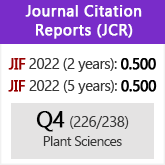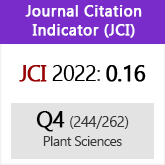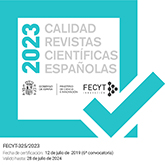The biology of Colletotrichum acutatum
DOI:
https://doi.org/10.3989/ajbm.2004.v61.i1.61Keywords:
Anthracnose, Ascomycete taxonomy, fungal diseases, infection, appressorium, host pathogen interactions, postharvest, fungicide, fruit, and disease controlAbstract
Colletotrichum acutatum is major pathogen of fruit crops, causing economically important losses of temperate, subtropical and tropical fruits worldwide. However, few studies have been carried out on key aspects of its biology. This is mainly because traditionally isolates of C. acutatum were often wrongly identified as C. gloeosporioides. Effective separation of the two species was not possible until the introduction of molecular tools for taxonomy. The life cycle of C. acutatum comprises a sexual and an asexual stage and much remains to be resolved regarding the genetics of sexuality and the effects of the sexual stage on population structure. Colletotrichum acutatum exhibits both infection strategies described for Colletotrichum species, i.e. intracellular hemibiotrophy and subcuticular-intramural necrotrophy, and may also undergo a period of quiescence in order to overcome resistance mechanisms in immature fruit such as pre-formed toxic compounds and phytoalexins, or due to the unsuitability of unripe fruit to fulfill the nutritional and energy requirements of the pathogen. Colletotrichum acutatum may overwinter as mycelium and/or appressoria in or on different parts of the host. Conidia are water-born and spread by rain episodes so infections are usually highest during the wettest periods of the growing season. Current management strategies for this fungus comprise the exploitation of cultivar resistance, cultural, chemical, and biological control methods, and preventive strategies such as disease-forecasting models. This review focuses on the current knowledge of biological aspects of C. acutatum and related Colletotrichum species and includes a discussion of the progress towards their control.
Downloads
Download data is not yet available.
Downloads
Published
2004-06-30
How to Cite
Wharton, P. S., & Diéguez-Uribeondo, J. (2004). The biology of Colletotrichum acutatum. Anales Del Jardín Botánico De Madrid, 61(1), 3–22. https://doi.org/10.3989/ajbm.2004.v61.i1.61
Issue
Section
Articles
License
Copyright (c) 2004 Consejo Superior de Investigaciones Científicas (CSIC)

This work is licensed under a Creative Commons Attribution 4.0 International License.
© CSIC. Manuscripts published in both the printed and online versions of this Journal are the property of Consejo Superior de Investigaciones Científicas, and quoting this source is a requirement for any partial or full reproduction.All contents of this electronic edition, except where otherwise noted, are distributed under a “Creative Commons Attribution 4.0 International” (CC BY 4.0) License. You may read here the basic information and the legal text of the license. The indication of the CC BY 4.0 License must be expressly stated in this way when necessary.
Self-archiving in repositories, personal webpages or similar, of any version other than the published by the Editor, is not allowed.
















